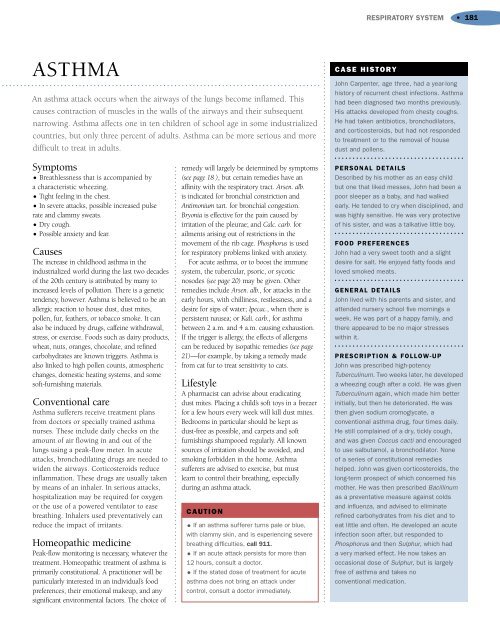Encyclopedia of Homeopathy
Encyclopedia of Homeopathy
Encyclopedia of Homeopathy
Create successful ePaper yourself
Turn your PDF publications into a flip-book with our unique Google optimized e-Paper software.
RESPIRATORY SYSTEM• 181ASTHMAAn asthma attack occurs when the airways <strong>of</strong> the lungs become inflamed. Thiscauses contraction <strong>of</strong> muscles in the walls <strong>of</strong> the airways and their subsequentnarrowing. Asthma affects one in ten children <strong>of</strong> school age in some industrializedcountries, but only three percent <strong>of</strong> adults. Asthma can be more serious and moredifficult to treat in adults.CASE HISTORYJohn Carpenter, age three, had a year-longhistory <strong>of</strong> recurrent chest infections. Asthmahad been diagnosed two months previously.His attacks developed from chesty coughs.He had taken antibiotics, bronchodilators,and corticosteroids, but had not respondedto treatment or to the removal <strong>of</strong> housedust and pollens.Symptoms• Breathlessness that is accompanied bya characteristic wheezing.• Tight feeling in the chest.• In severe attacks, possible increased pulserate and clammy sweats.• Dry cough.• Possible anxiety and fear.CausesThe increase in childhood asthma in theindustrialized world during the last two decades<strong>of</strong> the 20th century is attributed by many toincreased levels <strong>of</strong> pollution. There is a genetictendency, however. Asthma is believed to be anallergic reaction to house dust, dust mites,pollen, fur, feathers, or tobacco smoke. It canalso be induced by drugs, caffeine withdrawal,stress, or exercise. Foods such as dairy products,wheat, nuts, oranges, chocolate, and refinedcarbohydrates are known triggers. Asthma isalso linked to high pollen counts, atmosphericchanges, domestic heating systems, and somes<strong>of</strong>t-furnishing materials.Conventional careAsthma sufferers receive treatment plansfrom doctors or specially trained asthmanurses. These include daily checks on theamount <strong>of</strong> air flowing in and out <strong>of</strong> thelungs using a peak-flow meter. In acuteattacks, bronchodilating drugs are needed towiden the airways. Corticosteroids reduceinflammation. These drugs are usually takenby means <strong>of</strong> an inhaler. In serious attacks,hospitalization may be required for oxygenor the use <strong>of</strong> a powered ventilator to easebreathing. Inhalers used preventatively canreduce the impact <strong>of</strong> irritants.Homeopathic medicinePeak-flow monitoring is necessary, whatever thetreatment. Homeopathic treatment <strong>of</strong> asthma isprimarily constitutional. A practitioner will beparticularly interested in an individual’s foodpreferences, their emotional makeup, and anysignificant environmental factors. The choice <strong>of</strong>remedy will largely be determined by symptoms(see page 18 ), but certain remedies have anaffinity with the respiratory tract. Arsen. alb.is indicated for bronchial constriction andAntimonium tart. for bronchial congestion.Bryonia is effective for the pain caused byirritation <strong>of</strong> the pleurae; and Calc. carb. forailments arising out <strong>of</strong> restrictions in themovement <strong>of</strong> the rib cage. Phosphorus is usedfor respiratory problems linked with anxiety.For acute asthma, or to boost the immunesystem, the tubercular, psoric, or sycoticnosodes (see page 20) may be given. Otherremedies include Arsen. alb., for attacks in theearly hours, with chilliness, restlessness, and adesire for sips <strong>of</strong> water; Ipecac., when there ispersistent nausea; or Kali. carb., for asthmabetween 2 a.m. and 4 a.m. causing exhaustion.If the trigger is allergy, the effects <strong>of</strong> allergenscan be reduced by isopathic remedies (see page21)—for example, by taking a remedy madefrom cat fur to treat sensitivity to cats.LifestyleA pharmacist can advise about eradicatingdust mites. Placing a child’s s<strong>of</strong>t toys in a freezerfor a few hours every week will kill dust mites.Bedrooms in particular should be kept asdust-free as possible, and carpets and s<strong>of</strong>tfurnishings shampooed regularly. All knownsources <strong>of</strong> irritation should be avoided, andsmoking forbidden in the home. Asthmasufferers are advised to exercise, but mustlearn to control their breathing, especiallyduring an asthma attack.CAUTION• If an asthma sufferer turns pale or blue,with clammy skin, and is experiencing severebreathing difficulties, call 911.• If an acute attack persists for more than12 hours, consult a doctor.• If the stated dose <strong>of</strong> treatment for acuteasthma does not bring an attack undercontrol, consult a doctor immediately.PERSONAL DETAILSDescribed by his mother as an easy childbut one that liked messes, John had been apoor sleeper as a baby, and had walkedearly. He tended to cry when disciplined, andwas highly sensitive. He was very protective<strong>of</strong> his sister, and was a talkative little boy.FOOD PREFERENCESJohn had a very sweet tooth and a slightdesire for salt. He enjoyed fatty foods andloved smoked meats.GENERAL DETAILSJohn lived with his parents and sister, andattended nursery school five mornings aweek. He was part <strong>of</strong> a happy family, andthere appeared to be no major stresseswithin it.PRESCRIPTION & FOLLOW-UPJohn was prescribed high-potencyTuberculinum. Two weeks later, he developeda wheezing cough after a cold. He was givenTuberculinum again, which made him betterinitially, but then he deteriorated. He wasthen given sodium cromoglycate, aconventional asthma drug, four times daily.He still complained <strong>of</strong> a dry, tickly cough,and was given Coccus cacti and encouragedto use salbutamol, a bronchodilator. None<strong>of</strong> a series <strong>of</strong> constitutional remedieshelped. John was given corticosteroids, thelong-term prospect <strong>of</strong> which concerned hismother. He was then prescribed Bacillinumas a preventative measure against coldsand influenza, and advised to eliminaterefined carbohydrates from his diet and toeat little and <strong>of</strong>ten. He developed an acuteinfection soon after, but responded toPhosphorus and then Sulphur, which hada very marked effect. He now takes anoccasional dose <strong>of</strong> Sulphur, but is largelyfree <strong>of</strong> asthma and takes noconventional medication.
















